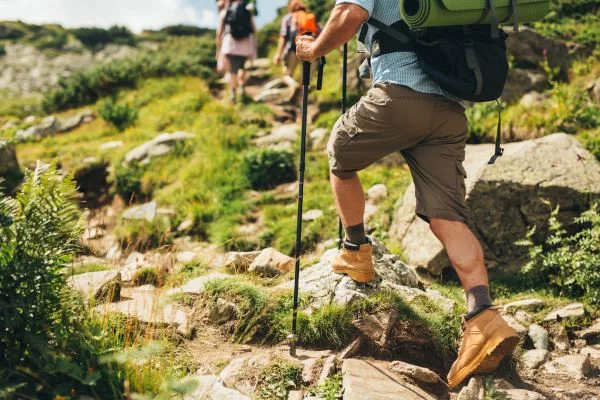Want to know, What Are The Different Types Of Hiking? Well, this blog is the key. Whether you’re an experienced hiker or just getting started, there are many different types of hiking to explore. From multi-day backpacking trips to leisurely day hikes, the possibilities are endless.
Each type of hike has its own unique set of advantages and challenges that makes it unique. Let’s take a look at some of the most popular types of hiking so you can find one that fits your style and goals.
What Are The Different Types Of Hiking?
Day Hikes
For those who only have a little time on their hands, day hikes are a great way to get out into nature without committing to an overnight trip. Day hikes typically range from 3-10 miles in length and often follow trails with moderate elevation changes.
This hike is perfect for those who want to get out and explore nature while still having time to come home and relax at the end of the day. Plus, they don’t require much gear or preparation beyond snacks, water, and appropriate clothing for the weather.
Multi-Day Backpacking Trips
If you’re looking for more adventure, a multi-day backpacking trip might be more up your alley. These trips involve carrying all your gear—including food, clothes, first aid supplies, shelters, etc.—with you as you traverse through multiple days’ worth of terrain over several miles.
These trips can be challenging and require careful planning ahead of time to ensure safety and success in the field. But if you’re up for it, these expeditions offer great rewards with spectacular views and experiences that last a lifetime!
Trail Running
Trail running is an excellent option for those looking for a more intense experience—or simply wanting to cover more ground faster. A Trail running combines walking/hiking and jogging/running into one activity where athletes cover long distances at high speeds over varying terrain, including hills, rocks, roots, mud, etc.
The Trail runners must be prepared physically (have strong muscles) as well as mentally (have focus & determination) because when trail running goes wrong, it can go wrong quickly!
It’s essential to know your limits when attempting this type of hike so that you don’t push yourself too far or put yourself in danger during your runs.
Also Read: How To Break In Hiking Boots?
Alpine Hikes
An Alpine hiking involves trekking through mountainous terrain that is often covered in snow or ice during certain times of the year. Alpine hiking requires specialized gear such as crampons, ice axes, and additional safety precautions due to the increased risk associated with these types of terrain.
Alpine hiking is an excellent way to experience the beauty of high-altitude mountains without climbing them—although it comes with its own set of challenges!
Also Read: Do I Need Hiking Boots?
Three Essential Skills in Hiking?

Hiking is one of the most rewarding outdoor activities. It provides an opportunity to explore nature and challenge yourself while getting some exercise at the same time.
But before you grab your hiking boots and hit the trail, there are a few essential skills that every hiker should know. So let’s take a look at three essential skills in hiking that will help you have a safe and enjoyable adventure!
Navigation
Navigation is key to any successful hike. Knowing your route and understanding how to read a map can help you stay on track and avoid getting lost. Before heading out, planning your route and determining where you’ll be going throughout the day is essential.
That means plotting out specific waypoints, marking off landmarks, and using a compass or GPS device if necessary. Having a good sense of direction is also helpful in staying on track.
If things get confusing or you are unsure which way to turn, make sure you take the time to consult your map or GPS device for guidance.
Safety & Self-Reliance
Safety should always be a top priority when hiking, so ensure that you are prepared for any potential emergencies that may arise during your trip. Make sure to carry items such as first aid kits, extra food, and water supplies, flashlights with extra batteries, emergency blankets or sleeping bags, fire starters, signaling devices (such as whistles), etc., just in case something goes wrong along the way.
Additionally, hikers need to practice essential self-reliance by being able to navigate the terrain without relying solely on modern technologies like cell phones or GPS devices. Knowing how to build shelters in harsh conditions or locate edible plants can be helpful!
Stamina & Endurance
Lastly, having good stamina and endurance is essential for any successful hike. A long day out on the trails can be exhausting, but with proper training and preparation ahead of time, hikers can increase their endurance levels.
Hence, they are better prepared for longer hikes with more significant elevation gains/losses (elevation refers to how high up above sea level you will be).
Training includes strength exercises such as squats or lunges and aerobic exercises like running or biking—all of which can help increase stamina levels over time so that hikers don’t tire too quickly during outdoor trips!
Also Read: How Should Hiking Boots Fit?
Conclusion:
Now you know, What Are The Different Types Of Hiking? No matter what type of hiking experience you’re looking for—whether it’s a stroll through nature or an intense challenge that tests both body & mind—there’s something out there for everyone!
Exploring different types of hiking can be rewarding because each offers its unique set of benefits & challenges, along with beautiful scenery & unforgettable memories! So grab your gear & get out there—the world awaits!



